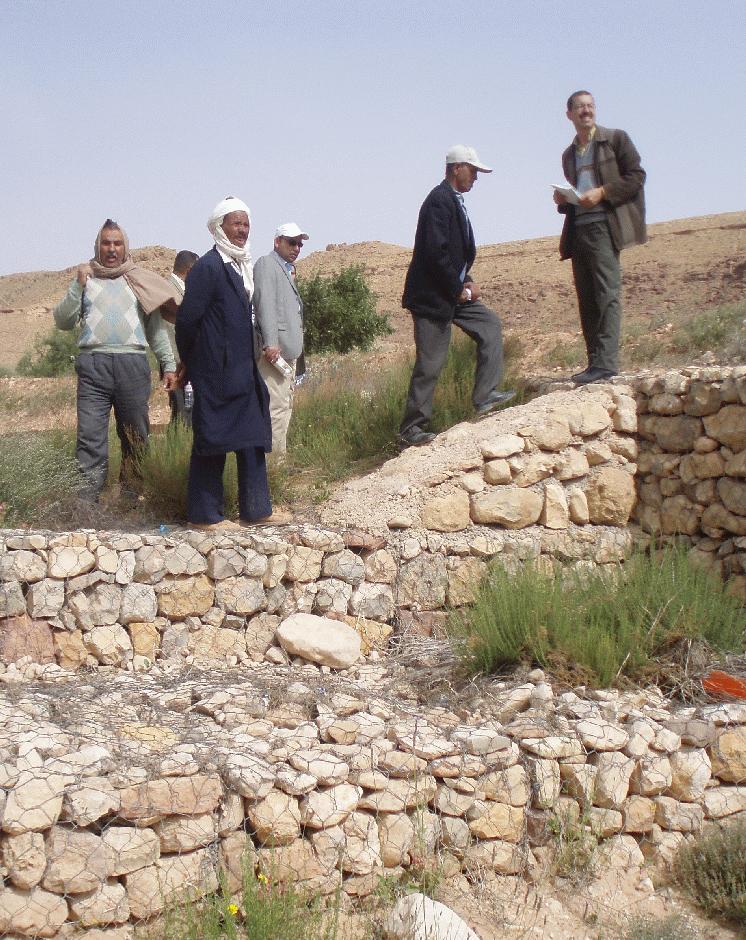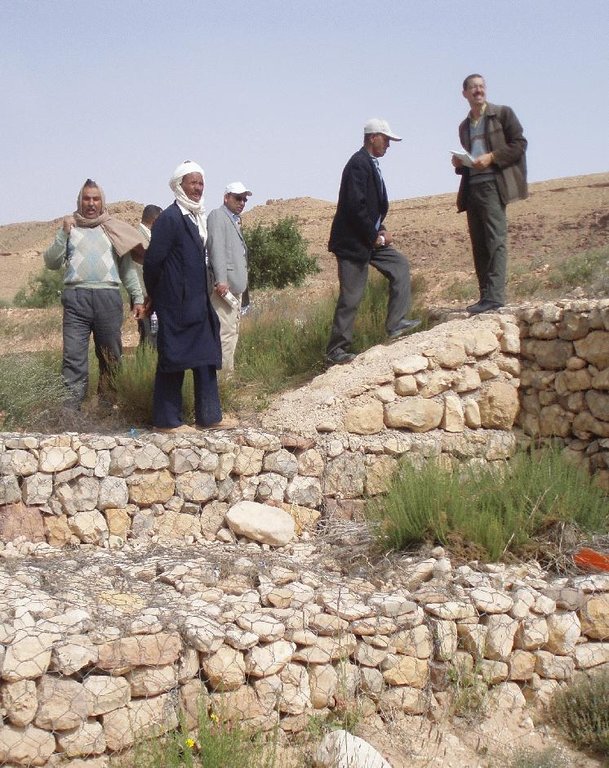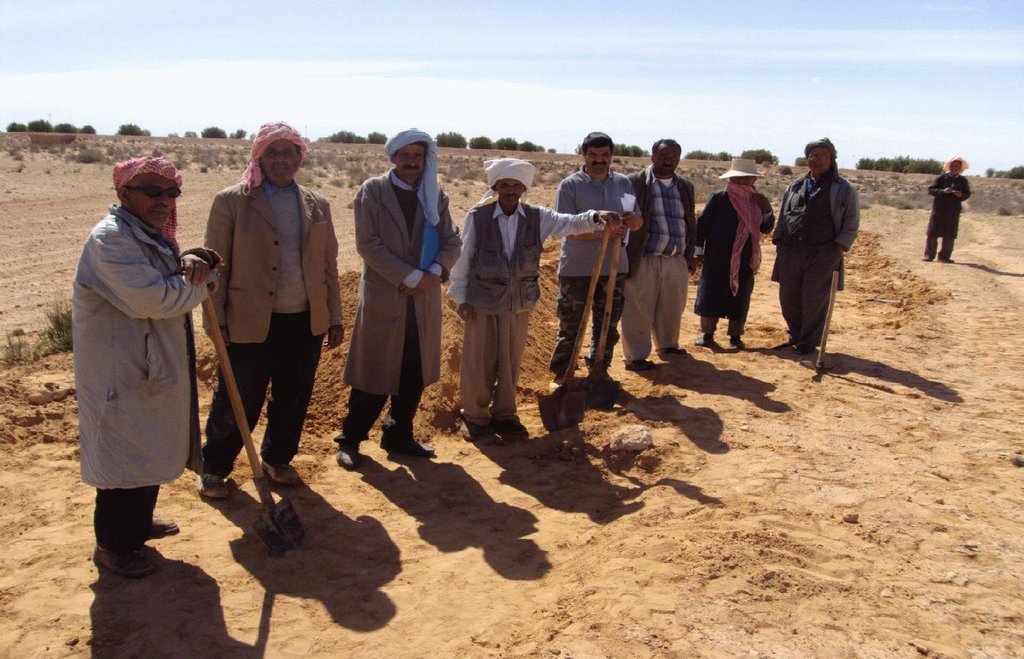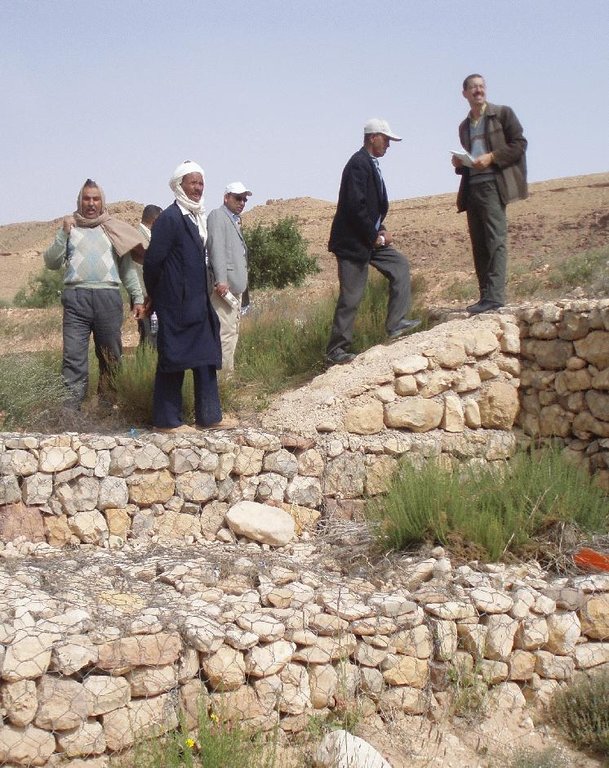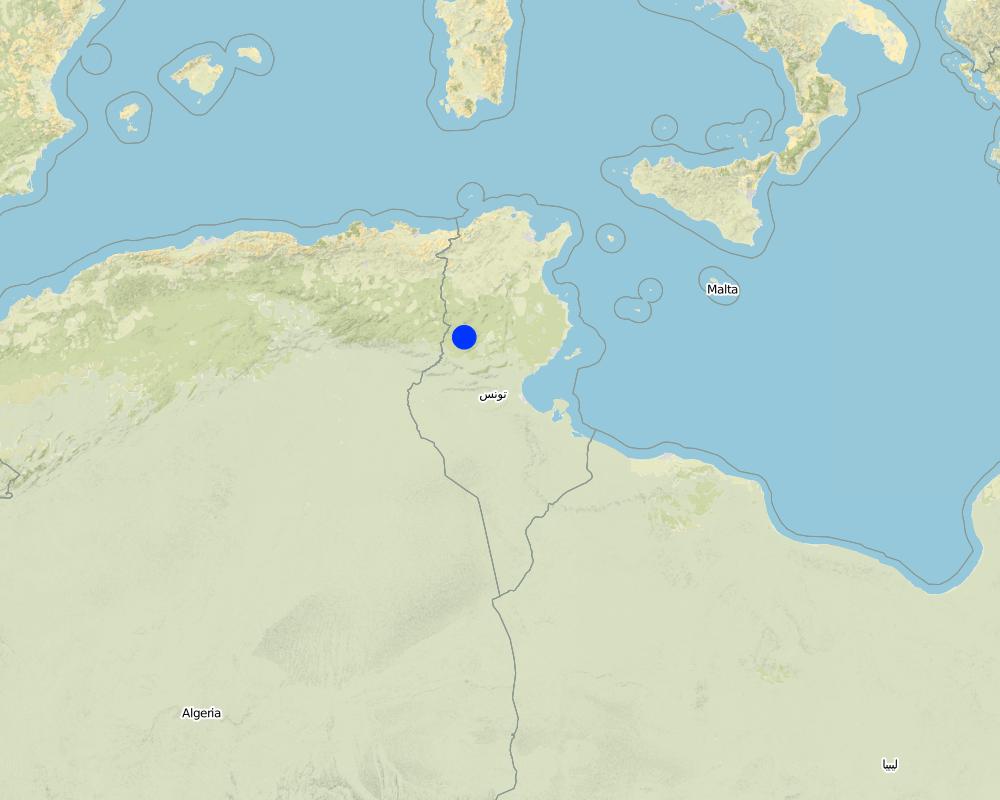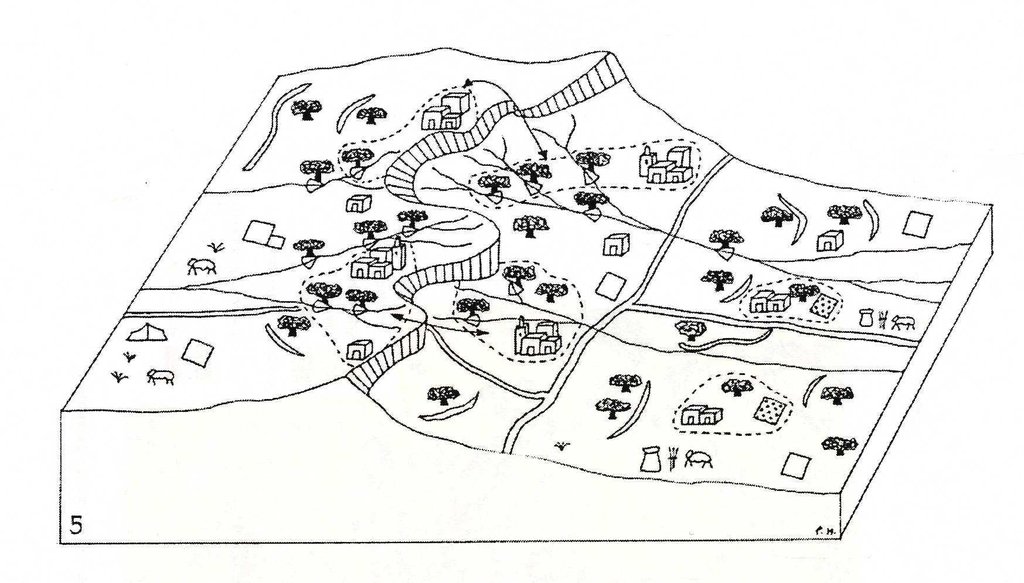Dryland watershed management approach [突尼斯]
- 创建:
- 更新:
- 编制者: Naceur Mahdi
- 编辑者: –
- 审查者: Fabian Ottiger
approaches_2422 - 突尼斯
查看章节
全部展开 全部收起1. 一般信息
1.2 参与方法评估和文件编制的资源人员和机构的联系方式
SLM专业人员:
SLM专业人员:
Sghaier Mongi
sghaier.mon@gmail.com
Institut des Régions Arides
4119 Medenine
突尼斯
有助于对方法进行记录/评估的机构名称(如相关)
Institut des Régions Arides de Médenine (Institut des Régions Arides de Médenine) - 突尼斯1.3 关于使用通过WOCAT记录的数据的条件
编制者和关键资源人员接受有关使用通过WOCAT记录数据的条件。:
是
1.4 SLM技术问卷的参考
2. SLM方法的描述
2.1 该方法的简要说明
Integrated land and water management approach, including vegetative, management, and agronomic measure
2.2 该方法的详细说明
该方法的详细说明:
Aims / objectives: The overall purpose of the approach is to prevent soil and water loss by combined measures and to provide a better environment. Soil and water conservation (SWC) technologies, based on harvesting area of surface water and underground water, are implemented to conserve soil and water and to improve the production and the biodiversity.
Methods: This approach is designed for the exploitation of water runoff for agricultural development, particularly for fruit trees cropping (mainly olives).This can be achieved through erosion reduction and aquifer recharge via runoff water infiltration into the terraces, slope angle and length reduction, runoff retaining, infiltration increase and soil loss reduction. The system is based on various runoff water harvesting systems, as jessour, tabias. It is marked by fruit tree development, notably olives. On the terraces, the fruit trees are arranged in inter-rows with the three main species encountered in the study areas. Generally, olive trees are planted, with in between rows almonds and/ or fig trees. SWC technologies play an importance role in arid zones. Since the 1970s, the Tunisian state has encouraged the local population to conserve water and soil in arid zone. Successive programmes and strategies of water and soil conservation have been developed and were implemented in all three natural regions of Tunisia (North, Centre and South).These techniques can be implemented by farmer with governmental subsidies or by government intervention in the projects and programmes of water and soil conservation. During the last decade, the Tunisian government implemented the first national strategy for soil and water conservation (1990-2000) and the second national strategy for soil and water conservation (2001-2011). These strategies mobilized important funds at national and regional levels. About 672.5 ha of SWC technologies were built and about 550 ha of SWC technologies are planned for the second national strategy.
Stages of implementation: 1) Assessment of the current natural resources and socio-economic conditions; 2) Proposition of actions at local and regional level; 3) Aggregation and coherence at the national level; 4) implementation of national action plan at local and regional level.
Role of stakeholders: Different levels of intervention are observed from the individual farm, through the community level, the extension / advisory system, the regional or national administration, or the policy level, to the international framework. The participative approach is usually applied in the construction of SWC technologies.
2.3 该方法的照片
2.5 采用该方法的国家/地区/地点
国家:
突尼斯
区域/州/省:
south-east of tunisia
有关地点的进一步说明:
Oum Zessar Watershed
Map
×2.6 该方法的开始和终止日期
注明开始年份:
1960
2.7 方法的类型
- 最近的本地倡议/创新
2.8 该方法的主要目的/目标
The Approach focused on SLM only (production, soil fertility, biodiversity, employement oppourtunities, food self-sufficiency, fixing population and stop farming exodus)
The objectives of the approach are to control soil and water loss to reduce floods and enhance fertility, to enhance rainfed agriculture productivity, to improve the livelihoods of farmers, to contribute to the production increase among farmers and pastoralists, to recharge the groundwater and to extend the area of cropland.
The SLM Approach addressed the following problems: The problems originate in the scarcity of water which is leading to conflicts over resource use between farmers. Oversized techniques leading to prevention of runoff from upstream to downstream reduce agricultural production and therefore the farm income, which causes a lack of cash to invest in SLM. In some cases irreversible land degradation is the result. The problems are mainly related to the lack of technical knowledge, the high costs of investment and the lack of tangible and assessable impacts of SWC activities, technically or socially.
2.9 推动或妨碍实施本办法所适用的技术的条件
财务资源和服务的可用性/可得性
- 阻碍
High cost investment
Treatment through the SLM Approach: Public projects (National strategy of SWC), subsidies
机构设置
- 阻碍
Land fragmentation, complexity of land tenure,
Treatment through the SLM Approach: Users organisation, participation
法律框架(土地使用权、土地和水使用权)
- 启动
The existing land ownership, land use rights / water rights greatly helped the approach implementation: The approach helped in the privatization of the land and has therefore greatly reduced the land/water use rights problems. This in turn has rendered the local interventions much more efficient.
了解SLM,获得技术支持
- 阻碍
Designing parameters
Treatment through the SLM Approach: Training , Ehancing SWC specialists guidance
3. 相关利益相关者的参与和角色
3.1 该方法涉及的利益相关者及其职责
- 当地土地使用者/当地社区
Working land users were mainly men (Men are the main force for field work.)
Special attention has been paid to make women participate in the approach. Nevertheless, men have much more technical knowledge and skills than women because if SWC technologies have to be constructed by manual labour, men can achieve more. Poor and old people are especially involved through their participation in the special programme against unemployment in rural area. Some unemployed young people may benefit from agricultural development programmes.
- SLM专家/农业顾问
The choice on the technology to use is made primarily by the technical specialists based on the prevalent type of erosion on each farm and farmers preference.
- 国家政府(规划者、决策者)
- 国际组织
如果涉及多个利益相关者,请注明领导机构:
National and state specialists together with land users.
3.2 当地土地使用者/当地社区参与该方法的不同阶段
| 当地土地使用者/当地社区的参与 | 指定参与人员并描述活动 | |
|---|---|---|
| 启动/动机 | 互动 | Farmers and local population are very familiar with traditional SWC applied. Therefore the receptiveness to these techniques is very high. There is state encouragement through subsidies. |
| 计划 | 互动 | Workshops/seminars; After a programme is granted, the implementing agency and local communities work together. |
| 实施 | 外部支持 | Responsibilities are divided into major steps; In practice, local communities are the major part to manage and carry out. |
| 监测/评估 | 互动 | Participative evaluation; Interviews/questionnaires. |
| Research | 互动 | It can give some suggestions or questionnaires. |
3.3 流程图(如可用)
具体说明:
The treatment of the catchment starts from the upstream and continues to piedmont areas, and ends in the downstream section of the catchment. Attention should be given to ensure sufficient water allocation to all the sections of the catchment as well as to the different users (rainfed agriculture and rangelands, irrigated areas, drinking water, industry and tourism).
作者:
Patricia Home
3.4 有关SLM技术选择的决策
具体说明谁有权决定选择要实施的技术:
- 主要是土地使用者,由SLM专家提供支持
解释:
consultative,explain
Decisions on the method of implementing the SLM Technology were made by mainly by SLM specialists with consultation of land users. Decisions are made by politicians/SWC specialists; land users are consulted in the planning phase (experienced farmers may be involved initially).
4. 技术支持、能力建设和知识管理
4.1 能力建设/培训
是否为土地使用者/其他利益相关者提供培训?:
是
明确受训人员:
- 土地使用者
- 现场工作人员/顾问
如果相关,请说明性别、年龄、地位、种族等。:
The capacity building programme and activities have benefited farmers representing the diversity of land users (women and men); representatives of NGO; local and external stakeholders, engineers and technicians responsible of the services of agriculture and forest.
培训形式:
- 农民对农民
- 示范区域
- 公开会议
涵盖的主题:
Training focused on teaching them how to design and build SWC technologies, how to implement these technologies and about the participatory approach.
4.2 咨询服务
土地使用者有权使用咨询服务吗?:
是
指明是否提供了咨询服务:
- 在固定中心
说明/注释:
Name of method used for advisory service: Integrated watershed management; Key elements: Training and demonstration open days, Demonstration plots implemented in private farms, Target farmers groups are visited by specialist to help and advise them.; 1) Advisory service was carried out through: government's existing extension system. Extension staff: mainly government employees 3) Target groups for extension: planners; Activities: training
Advisory service is quite adequate to ensure the continuation of land conservation activities; The extension system is adequate to ensure continuation of activities. At each governorate level, there is a SWC division which is in charge of SWC activities, including its extension.extension
4.3 机构强化(组织发展)
是否通过这种方法建立或加强了机构?:
- 是,适度
具体说明机构的强化或建立程度:
- 本地
具体说明支持类型:
- 财务
提供进一步细节:
support with financial resources, capacity building, training, institutional support. The financial schema is made of three main components: self-financing from farmers and beneficiaries, subsidies from the government and credit from bank.
4.4 监测和评估
监测和评估是该方法的一部分吗?:
是
注释:
economic / production aspects were ad hoc monitored by project staff through measurements; indicators: investigation/ of yield, income of land users, rainfed productivity
socio-cultural aspects were ad hoc monitored by project staff through observations; indicators: Investigation of land users perceptions of cultural change
bio-physical aspects were ad hoc monitored by project staff through measurements; indicators: Indicators are runoff loss, sediment load, soil moisture
area treated aspects were ad hoc monitored by government through measurements; indicators: Impact assessment
management of Approach aspects were None monitored by government through measurements; indicators: None
There were few changes in the Approach as a result of monitoring and evaluation: for example at the institutional level.
4.5 研究
研究是该方法的一部分吗?
是
明确话题:
- 技术
- approaches
提供进一步的细节,并指出是谁做的研究:
Land users have been involved. SWC technologies construction is based on scientific design, according to local conditions.
Research was carried out both on station and on-farm
5. 融资和外部物质支持
5.1 该方法中SLM组成部分的年度预算
如果不知道准确的年度预算,请给出一个范围:
- 10,000-100,000
注释(例如主要的资助来源/主要捐助者):
Approach costs were met by the following donors: local community / land user(s): 20.0%; national non-government: 5.0%; government: 55.0%; international: 20.0%
5.2 为土地使用者提供财政/物质支援
土地使用者是否获得实施该技术的财政/物质支持?:
是
5.3 对特定投入的补贴(包括劳动力)
- 设备
| 具体说明哪些投入得到了补贴 | 程度如何 | 对补贴做出具体说明 |
|---|---|---|
| 机械 | 部分融资 | |
- 建筑
| 具体说明哪些投入得到了补贴 | 程度如何 | 对补贴做出具体说明 |
|---|---|---|
| 石料 | 部分融资 | |
如果土地使用者的劳动力是一项重要的投入,那么是不是:
- 自愿
注释:
Voluntary but rewarded with in-kind support by government subsidies
5.4 信用
是否根据SLM活动的方法给予信用值?:
是
对条件(利率、回报等)进行具体说明:
repayment conditions: Credit was promoted through agricultural banks with various interest rates, usually lower than market rates.
6. 影响分析和结论性陈述
6.1 方法的影响
该方法是否帮助土地使用者实施和维护SLM技术?:
- 否
- 是,很少
- 是,中等
- 是,支持力度很大
Land users can harvest water and irrigate crops in dry seasons. Meanwhile, the cropland area is enlarged.
该方法是否有助于社会和经济弱势群体?:
- 否
- 是,很少
- 是,中等
- 是,支持力度很大
for disadvantaged women and men, there are employment opportunities and food self-sufficiency
该方法是否改善了阻碍SLM技术实施的土地使用权/用户权问题?:
- 否
- 是,很少
- 是,中等
- 是,支持力度很大
Did other land users / projects adopt the Approach?
- 否
- 是,很少
- 是,中等
- 是,支持力度很大
Did the Approach lead to improved livelihoods / human well-being?
- 否
- 是,很少
- 是,中等
- 是,支持力度很大
because of increased farm income.
Did the Approach help to alleviate poverty?
- 否
- 是,很少
- 是,中等
- 是,支持力度很大
this appraoch increase farm income, food self-sufficiency and employer opportunities
6.2 土地使用者实施SLM的主要动机
- 增加生产
increase yield; Food self-sufficiency
- 增加利润(能力),提高成本效益比
increase farm income
- 支付/补贴
invest in SWCT
- well-being and livelihoods improvement
Employer opportunities
6.3 方法活动的可持续性
土地使用者能否维持通过该方法实施的措施(无外部支持的情况下)?:
- 不确定
若否或不确定,请具体说明并予以注释:
Can given the recent escalation in payments made to land users for implementation under certain projects it seems that the costs will be too high to sustain. Currently the Ministry of Agricultural is demanding that in-depth cost-benefit analyses are carried out involving environmental, social as well as economic assessments
6.4 该方法的长处/优点
| 土地使用者眼中的长处/优势/机会 |
|---|
| Reduction of soil erosion (How to sustain/ enhance this strength: ensure the durability of the works implemented) |
| 编制者或其他关键资源人员认为的长处/优势/机会 |
|---|
| Improvement of livelihood (How to sustain/ enhance this strength: spreading and improvement of a more holistic SLM approach focusing on livelihoods) |
| Many people involved and trained at different levels (pyramid system) (How to sustain/ enhance this strength: participatory approach) |
| More participation and involvement of local population (How to sustain/ enhance this strength: Improve participatory approach and increase confidence between partners) |
6.5 该方法的弱点/缺点以及克服它们的方法
| 土地使用者认为的弱点/缺点/风险 | 如何克服它们? |
|---|---|
| Abandonment of the works, less maintenance | Continue to support farmers and local institution and organisation. Repairing and maintaining in time. |
| Low impact on livelihood conditions | improve efficiency of SWC activities and participatory approach |
| 编制者或其他关键资源人员认为的弱点/缺点/风险 | 如何克服它们? |
|---|---|
| Less confidence between partners and less participation | improve dialog and communication; improve efficiency of SWC activities and participatory approach. |
| High costs: farmers depend on external support from the government; they are not willing to invest their labour without payments | New approach should give farmers loans for construction as now they use machines to do the work. In addition, search for cheaper SWC technologies and for improving the benefits. |
7. 参考和链接
7.1 方法/信息来源
- 实地考察、实地调查
- 与土地使用者的访谈
7.2 参考可用出版物
标题、作者、年份、ISBN:
Genin D., Guillaume H., Ouessar M., Ouled Belgacem A., Romagny B., Sghaier M., Taamallah H. (Eds) 2006. Entre la désertification et le développement : la Jeffara tunisienne. CERES, Tunis; de Graaff J. & Ouessar M. (Eds.) 2002Water harvesting in Mediterranean zones: an impact assessment and economic evaluation.
可以从哪里获得?成本如何?
TRMP paper n° 40, Wageningen University, The Netherlands
标题、作者、年份、ISBN:
Water harvesting in Mediterranean zones: an impact assessment and economic evaluation.
可以从哪里获得?成本如何?
TRMP paper n° 40, Wageningen University, The Netherlands
链接和模块
全部展开 全部收起链接
无链接
模块
无模块


